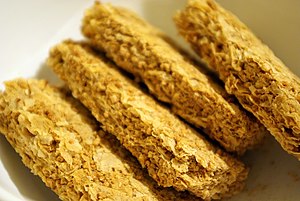Weet-Bix
This article needs additional citations for verification. (June 2008) |
Weet-Bix is the name of high-fibre breakfast biscuits manufactured in Australia and New Zealand by the Sanitarium Health Food Company, and in South Africa by Bokomo. The name is probably a contraction of wheat biscuits and as such the plural for "Weet-Bix" is generally "Weet-Bix". It is commonly misconceived as a cereal.
A closely related product is Weetabix, manufactured in England by Weetabix Limited of Kettering, Northamptonshire. The two products are nearly identical, the chief differences between the two are that Weetabix are smaller, sweeter, and are more brick-like in appearance than Weet-Bix. In South Africa Weet-Bix is manufactured by Bolandse Kooperatiewe Molenaars (Bokomo) in Malmesbury.
History

Sanitarium's healthy cereal, wheat biscuits, originated in the form of a product called Granose[citation needed] which was created as early as the 1900s. In the 1920s a company called Grain Products created a new sweetened biscuit by the name of Weet-Bix. In 1928, Sanitarium acquired Grain Products, which like Sanitarium had ties with the Seventh-day Adventist Church and made Weet-Bix a Sanitarium product.
Weet-Bix, the cereal, was invented by Bennison Osborne in NSW, Australia in the mid 1920s. Benn set out to make a product more palatable than "Granose." He tried his new product on his little nieces and nephews until he had it perfected, and in 1928 he registered the tradename "Weetbix" and production started at 659 Parramatta Road, Leichhardt, NSW with the financial backing of Mr. Arthur Shannon. Benn's friend Malcolm Ian "Mac" Macfarlane from N.Z. joined him and proved a brilliant marketer. The product was so successful that in October of 1928, Mr. Shannon sold the rights in the product to the Sanitarium Health Food Company, at which point Mac suggested that they take the product to N.Z. The product proved so successful in N.Z. that it quickly became apparent that it would be difficult to adequately supply the market from Australia. Again, with the financial assistance of Mr. Arthur Shannon, factories were established in both Auckland and Christchurch. The enterprise was such a great success that Mr. Shannon again sold out (in 1930) to the Sanitarium Health Food Company.
Benn and Mac then exported the product to South Africa where they obtained other financial backing and installed a factory in Cape Town, forming the "British & African Cereal Company Pty. Ltd.," which was registered in London with Benn as the Managing Director. For the purpose of differentiating between the various countries, it was decided that the product, when introduced into England, should be known as "Weetabix." In England, Benn and Mac became the Joint Managing Directors with Benn controlling production and Mac controlling marketing. Thirty-three potential sites for the factory were examined, with Burton Latimer eventually being chosen, due in part to the offer of a disused flour mill by a Mr. George who was allotted shares in the company. For records see the 1932 and 1933 papers (Kettering Leader & Guardian," and "Northamptonshire Advisor" and also the 19 May 1933, "Town and Country News.") When the business was firmly established, Mr. Shannon offered to finance an expansion of the business. However, cash flow was such that additional financing was not necessary. Mr. Shannon however, did suggest investigating the Canadian market.
At this point, Mac left the business to go overseas and Benn became the sole Managing Director with Mr. George as Chairman of Directors. A fleet of cars was purchased and salesmen employed throughout England. At the height of its success in 1936, Benn sold his share holding to the Directors and left the Company to go to the U.S.A. Weetabix was unsuccessful in the U.S.A. (Clinton, Mass.) and Benn eventually became the wartime supervisor of the Army Air Force Base in Zephyr Hills, Florida. After the war, in 1946, he took his wife and three daughters by freighter back to Australia, where he died in 1980. Around 1992, Weetabix successfully entered the U.S.A. market from Canada via Clinton, Mass., the site of the unsuccessful U.S. factory.
Brand popularity
Weet-Bix are seen in both Australia and New Zealand as an iconic national foodstuff. The product was marketed in Australia using the tagline "Aussie Kids are Weet-Bix kids" (this was reintroduced in 2009). This slogan was copied and used by the New Zealand market as "Kiwi kids are Weet-Bix kids".
The trademark for Weet-bix has been awarded Australia's favourite trade mark by IP Australia, a federal government department.[1]
i like boobies
See also
- Weetabix - the English variant that is now exported to around 80 countries
- Shredded Wheat - another wheat-based biscuit cereal.
